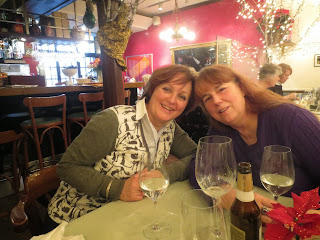The small lakeside town of Zug is a lovely place to visit at any time: it always exudes a holiday atmosphere. In summertime there are the added pleasures of enjoying a coffee or a cold drink in one of the open air cafes near the lake, taking a ride on a pedalo or enjoying lunch on a boat while cruising around the lake of Zug. On Thursday 25 July, the
ZIWA Discovering Zurich and Switzerland group did just that. Except the pedaloes - we saved that watery pursuit for another day.
Exploring Zug
Fast trains to Zug run every half an hour from Zurich HB, Thalwil and Luzern. From Zug station it's a 10 minute walk to the lake, where to the right one can find the departure point for
short and long cruises around the beautiful and peaceful Zugersee. Strolling left lakeside past the gardens and the twin swans sculpture, one reaches the main square, the
Landsgemeindeplatz. From here the Lunch Boats depart, pedalo and motor boat hire can quickly be arranged, or one can sit on the terraces of cafes
Domus or
Muehle to enjoy a drink and take in the atmosphere. Beside the lake there are two large aviaries, home to scarlet ibis, avocet, golden pheasant and snowy owls.

Then a short stroll will take you around the
Altstadt or old town streets of Fischmarkt, Ober-Altstadt and Unter-Altstadt. Here there are many small chic shops, art galleries and restaurants as well as the Fischerei Museum. This is the site of the plaque commemorating the floods of 1435 when 60 local people lost their lives. The bronze Greth Schell fountain is a curiosity - the old lady carries the devil on her back. Look out for the two-level shopping parade and the antique shop signs.
Above the old town in Kolinplatz stands the
Zytturm or clock tower, and from the top there's a great view over the rooftops of Zug and the outlook towards the Zugersee, the hill which overshadows the town and is worth a climb on another occasion. A favourite restaurant is the
Liguria, formerly known as the Hecht, with the sign of the pike. Its airy dining room offers a terrific view over the lake and the menu and service are something special. For a more traditional venue, you could also try the Restaurant Aklin or the Rathauskeller.
 Treat yourself to lunch on board!
Treat yourself to lunch on board!
It's advisable to book ahead for this splendid lunch service. The lunch boats depart from the Landsgemeindeplatz on Wednesdays and Thursdays in the summer months. The service is particularly good and the choice of menus very reasonable. For the price of CHF33 with Halbtax, one can enjoy a two course lunch with a choice of two salads and five fish, meat or vegetarian dishes. For a couple of francs more there's also a Business Lunch menu with a similar number of options. Coffee and drinks are extra. The meal is quickly served, allowing time to gaze out onto the view of the banks of the Zugersee and the small towns of Buonas, Oberwil and Cham.
Markets and stores
The cherry season normally occurs in June and July, and we were just in time to sample the selection of large, juicy cherries at the
Chriesimaert in the main square. The best cherries I've tasted all year! Nearby in the new town is a branch of department store Manor, a bookshop with a great selection of English books, and many other shops and stores. There's a large car park Neustadt by Coop which can be reached from the main road inwards from Zurich. Parking is also possible at Casino.
Open air concerts
In summer there are open air concerts held in the main square, the Landsgemeindeplatz, every Wednesday evening. So find a table in one of the lakeside cafes and sit back and enjoy the atmosphere.
Try our quiz!
ZIWA Discoverers always keep their eyes open for curiosities and fascinating facts. Try our quiz! Fourteen people took part, and six completed the quiz correctly. The winning tie-breaker slogan 'I like discovering Zug because of ... its
beautiful setting, nice old town, good
restaurants' was suggested by regular group member Helga, who won a bottle of Kirsch.
 How well do you know Zug? Answers are at the bottom.
How well do you know Zug? Answers are at the bottom.
1. What two
famous mountains can you see in Zug on a good day?
2. What
popular summer fruit can you buy at the Zuger Chriesimärt?
3. Which of
the following boats might you see on the Zugersee (tick 1 or more)?
Rigi, Zug, Gotthard, Schwyz
4. What is the
name of the hill which overlooks Zug?
5. When did
60 people lose their lives in floods (look around in the Altstadt)?
6. Which of
these places is not a stop on the Zug boat trips?
a) Buonas b) Oberwil c)
Weggis
7. What is
the name of the old woman in the fountain at Unter Altstadt?
8. What
score was awarded to the Rathauskeller by the Guide Bleu?
9. When was
Aklin the butcher’s founded?
a) 1862 b)
1892 c) 1856
10. What
fish is the former name of the Restaurant Liguria?
Find out more
For more information about Zug and the boats on the lake, see these links:
For a little piece of heaven in central Switzerland, hurry and make a trip to Zug. You won't regret it!
Quiz Answers:
1. Rigi,
Pilatus. 2. Cherries. 3. Rigi, Zug, Schwyz. 4. Zugerberg. 5. 4 March 1435. 6.
Weggis. 7. Greth Schell.8. 7.5. 9. 1862. 10. Hecht (Pike).
Written by Julia Newton, 31 July 2013.


















































